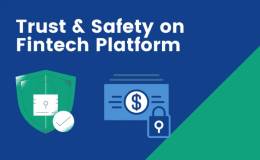Perhaps, the most common mistake made by retail companies in planning and executing digital transformation is to treat technology acquisition as a goal in itself. You will find that the code of “people first” as the golden rule of retail digital transformation will make great sense if you start to follow this rule.
Organizations that make this mistake are laboring under the slightly blinkered belief that technology is disrupting retail, but that’s simply not the case. People are the agents of disruption, while digital technology is merely an instrument that aids them in the role.
Similarly, it is people (and the way they live) who are impacted by the changes arising from technologies. Companies that understand and embrace this reality have a more effective approach to their custom web application development projects as part of digital transformation efforts, and this way can secure better results through people-oriented design. At the same time, operators putting technology first also put themselves at a disadvantage.
5 Principles of “People First.”
The journey toward retail digital transformation, when guided by the ‘people first’ principle, is one in which retail companies adopt people-oriented objectives, with the ‘people’ element made up of customers, employees, and business partners.
People-first is not just one principle but a set of at least five codes of conduct — which collectively provide the direction in the quest for digital transformation. The five principles can be defined as follows:
1. Digital transformation is a journey with the sole objective of helping people to live, work, and play in smarter and better ways.
2. Digital transformation is about adapting to what people want and need, not vice versa.
3. Digital transformation should connect people seamlessly and support real-time information sharing and collaboration.
4. Mobility is not a technology or a device but a state of human existence supported by technologies and devices.
5. People need to know that technology is transparent, and helps them to stay safe and secure, while also enhancing human abilities and experiences.
People-first Objectives for Retail Digital Transformation.
If your enterprise understands the collective principles of putting people first, it’s already ahead of the curve in how prepared it is for digital transformation, even if the transformation itself has not even started. Certainly, you are ahead of less enlightened competitors, even those that are busily investing money and effort into hi-tech solutions but not keeping the people-first principles in mind.
However, it’s not always easy to determine the objectives of such human-centric projects. Of course, much depends on your company’s general course, but needless to say, digital transformation should be focused on your customers, business partners, employees, or all the three groups at once.
In taking the people-first approach to digital transformation, you can adopt any of the following objectives:
- Equip sales staff with technology enabling them to be proactively insightful.
- Improve customer experience through the use of intelligent automation.
- Leverage digital technology to improve workforce agility.
- Develop continuous learning capabilities to accelerate employee development.
- Improve cross-functional and inter-company collaboration.
- Augment retail product sales with a portfolio of value-adding services.
- Increase customer trust and confidence through improved data security and governance.
These are purely examples and as such are not precise objectives. Yet, they are intended to represent the angles from which your executive team might approach the use of digital technology to transform the enterprise while keeping people at the front and center of this transition.
Now, let’s take a look at some of these objectives in a little more detail, and explore how you might deploy digital technology in order to meet them.
Employee-centric Objectives
The recent research by PwC suggests that there is a gap in how executive managers and their subordinates view the technology at work. While 90% of the surveyed executives believe they prioritize their staff’s needs when introducing new work-aiding tech, only 53% of employees agree with this.
To bridge this gap, retailers need to think in terms of their sales staff’s daily challenges that could be alleviated, not obstructed, with technology.
The first step would probably be to equip staff on the sales floor with tablets, enabling them to check product availability and prices while attending to customers.
The next step might be to provide mobile enterprise apps linked to the CRM platform. With the aid of advanced analytics, these apps could push out cross-sell and upsell suggestions to sales associates, perhaps triggered by some electronic cue from customers’ mobile devices transmitted via in-store retail beacons.
By now, you may be wondering if the deployment of mobile solutions is really about helping employees or simply about making more sales—and of course the answer is both. However, there’s nothing wrong with a win-win situation.
Customer-centric Objectives
Any objectives aimed at business partners and employees are ultimately customer-centric, but the magic of digital technology is that it can be applied directly to interactions between your enterprise and your customers, whether with the goal of improving customer care, generally enhancing customer experience, or stimulating purchasing activity.
Most retail companies begin their digital transformation by developing mobile apps for customers to download. They might then go on to increase engagement with the aid of beacons or other location-sensing technology.
One of the examples is Nike Connected Jersey. This innovative mobile and IoT campaign allows the brand’s NikeConnect App users to scan specially designed jersey tags to unlock multiple extras such as courtside game tickets, exclusive products, game highlights, and more. This is the power of connected retail technologies in action, which propagates customers’ engagement through playful experiences.
Get in Touch with the “Why.”
The most exciting part in projects like Nike’s is not the innovative technology itself, but what the technology does for the customer. Of course, for every front-runner, there will be a raft of retail companies that see what these pioneers are doing and then emulate it — but with little thought as to why.
This is the technology trap that awaits unwary retailers and can leave them technology-rich but progress-poor. To avoid falling into this trap, prepare for your company’s digital transformation by asking yourself and your executive team the following questions:
- Which customer touchpoints can be made faster, more efficient, or better integrated?
- Which digital technologies can bring about the desired touchpoint improvements?
- How well does our company collaborate across internal functions and with external partners?
- Can digital technology make a meaningful difference to collaboration in our organization?
- How can technology aid our sales associates to work with more agility, efficiency, and effectiveness?
Soft Skills Trump Technological Talent
While this article is heavily oriented toward people as the subjects of retail digital transformation, it’s important to keep in mind the fact that people — not technology — are also the agents of transformation. To that end, your company should ensure the necessary talent exists to apply transformative technologies.
Surprising as it may seem, this doesn’t mean your organization must be densely populated with technological masterminds, even though you are embarking on a ‘digital’ transformation. In reality, you should be able to field project teams with appropriate soft skills to mobilize and drive digital initiatives.
It’s important to prioritize soft skills, in particular leadership, when going through changes induced by digital transformation. That’s what was highlighted in a recent interview by Adobe’s Director of Talent Development Danielle Clark, who made a case for extra training and guidance to reduce employees’ anxiety about current technological disruptions in the workplace.
After all, technology doesn’t need to be driven — but people do. Keep in mind that no amount of technological genius will inspire the cultural changes necessary for successful digital transformation.
Make People Your Digital Prerogative
When considering digital transformation in your retail enterprise, make it all about the “who,” and the “what, why, how, and where” will naturally follow. Various technologies available to you are all powerful tools, but their potential means little without people-oriented objectives to drive technology implementation and use.










